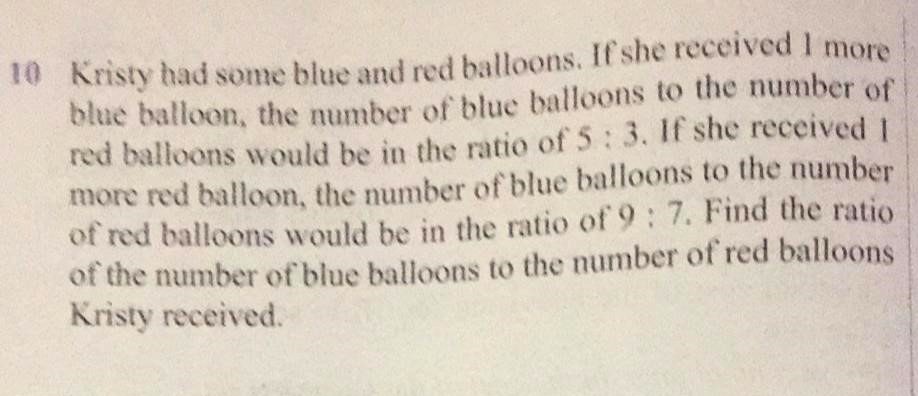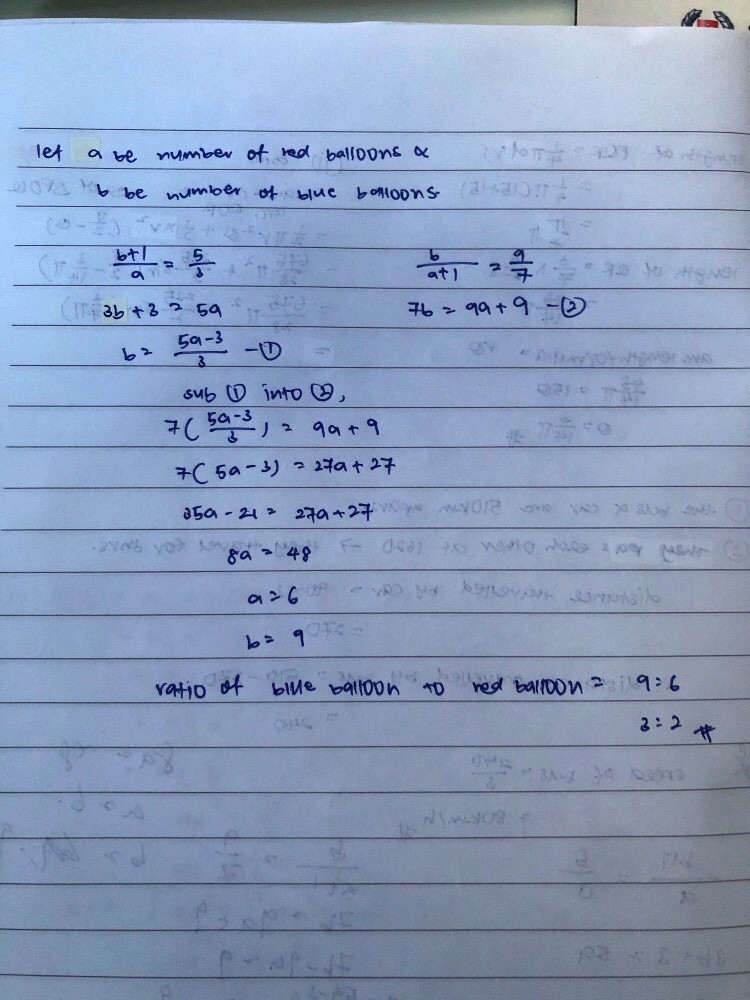Ask Singapore Homework?
Upload a photo of a Singapore homework and someone will email you the solution for free.

Question
primary 6 | Maths
One Answer Below
Anyone can contribute an answer, even non-tutors.

Please help with the steps! Thanks
"If she received 1 more blue balloon, blue : red will be 5 : 3"
This means that the number of blue balloons leaves a remainder of 4 when divided by 5, and the number of red balloons is exactly divisible by 3.
"If she received one more red balloon. blue : red will be 9 : 7".
This means that the number of blue balloons is exactly divisible by 9 while the number of red balloons leaves a remainder of 6 when divided by 7.
-----------------------------------------------
So, blue is divisible by 9 but leaves a remainder of 4 when divided by 5.
Red is divisible by 3 but leaves a remainder of 6 when divided by 7.
Numbers which are divisible by 9 but leave a remainder of 4 when divided by 5 are 9, 54, 99 and so on.
Numbers which are divisible by 3 but leaves a remainder of 6 when divided by 7 is 6, 27, 48, 69, 90, ...
By checking each value, we realise that she must currently have 9 blue balloons and 6 red balloons.
The simplest ratio for this is 3 : 2.
"If she received 1 more blue balloon, blue : red will be 5 : 3"
Number of blue balloons now: 5 units - 1
Number of red balloons now: 3 units
"If she received one more red balloon. blue : red will be 9 : 7".
Number of blue balloons now: 9 parts
Number of red balloons now: 7 parts - 1
----------------------------------------------------------
In both cases, we are referring to the same balloons.
5 units - 1 = 9 parts --> Eq 1
3 units = 7 parts - 1 --> Eq 2
From Eq 1, we see that
5 units = 9 parts + 1
Three sets of this will give us
15 units = 27 parts + 3 --> Eq 3
From Eq 2, we see that
3 units = 7 parts - 1
Five sets of this will give us
15 units = 35 parts - 5 --> Eq 4
The 15 units in both Eq 3 and Eq 4 also refer to the same amount, so
27 parts + 3 = 35 parts -5
5 + 3 = 35 parts - 27 parts
8 = 8 parts
8 parts = 8
1 part = 1
So, 3 units
= 7 parts - 1
= 7 x 1 - 1
- 6
1 unit is 2.
So, starting number of blue balloons
= 9 parts
= 9 x 1
= 9
Starting number of red balloons
= 3 units
= 3 x 2
= 6
So the starting ratio is 9 : 6, or 3 : 2.
See 1 Answer
They are not so likely to absorb your equations using a and b since English phrases like unit and part are easier for them to grasp than algebraic expressions like a and b.
They are Primary 6 students who only learn the most basic of algebra in Primary 6.
Your removal of fractions, two lines after "Sub 1 into 2", may be hard for them to visualise or understand at their level.




